Building a Nation
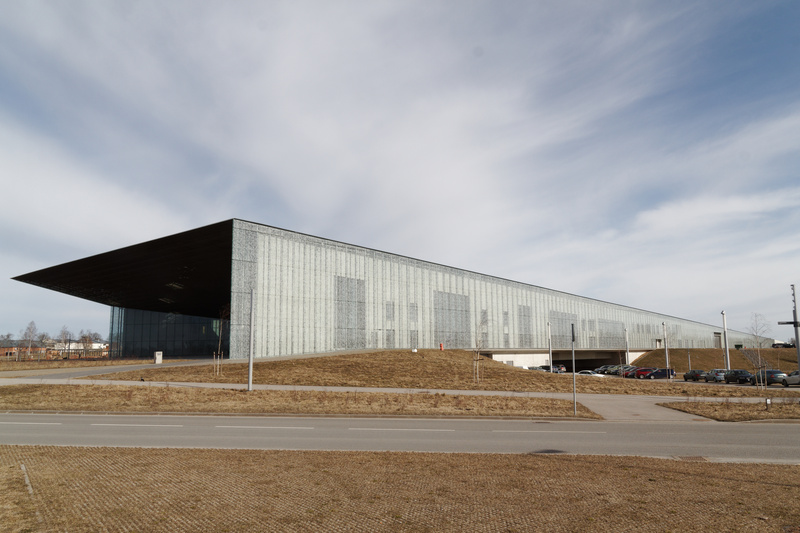
The Estonian National Museum in Tartu. |
I left my hotel, crossed the river, and headed for the outskirts of town. Eventually I passed out of the town entirely, into the countryside. And there, in the middle of an empty field, stood a huge, modern extraordinary-looking glass building. It seemed to change shape depending on which angle you looked at it from.
This was the Estonian national museum, just outside the city of Tartu.
I had come here to look at their documentation of Estonian farmhouse brewing. I already had some archive references, which I'd asked them to prepare, and I'd also asked them to please get me more material on brewing if they had any.
A friendly Estonian lady showed me the way to a desk where everything was already laid out. Going through it I quickly found the answers to the 1993 questionnaire I asked for on farmhouse brewing, the documents in the correspondence collection, and so on.
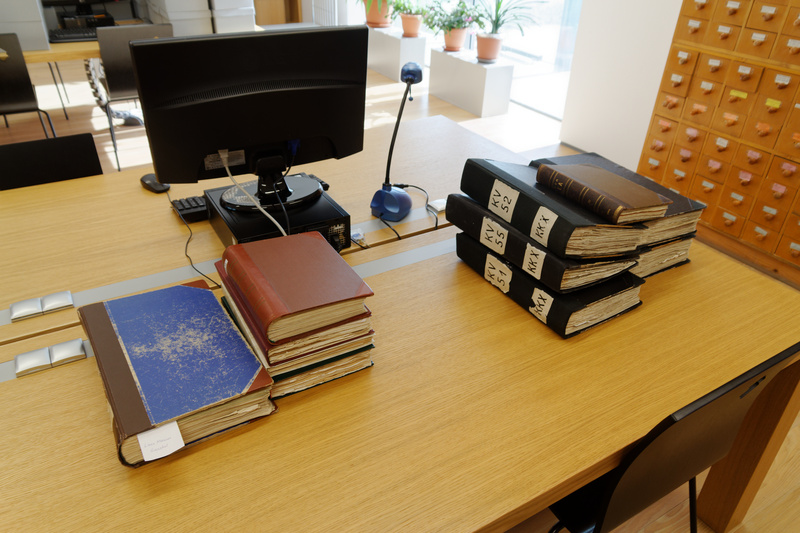
The documents. |
There were also five huge black volumes that I didn't know what were, but the lady explained these were the answers to questionnaire X, issued in the 1930s. It turned out to be questions on food and dining customs, with a section on drinks, including home-brewed beer.
Each volume was hundreds of pages, and there were five of them. A massive amount of information.
As I started going through them the answers turned out to be from all kinds of people. In some cases entire school classes had apparently been given the questionnaire to fill in as homework, and the answers sent to the national museum.
The friendly lady explained to me what the codes on the spines of these volumes meant: "KK X KV 52". Questionnaire X, volume 52. The last volume was number 55. 55 books this size!?!
At least ten thousand pages where individual Estonians had painstakingly described their personal food customs in detail. Estonians had clearly put an immense amount of volunteer labour into providing this gigantic trove of information.
Why?
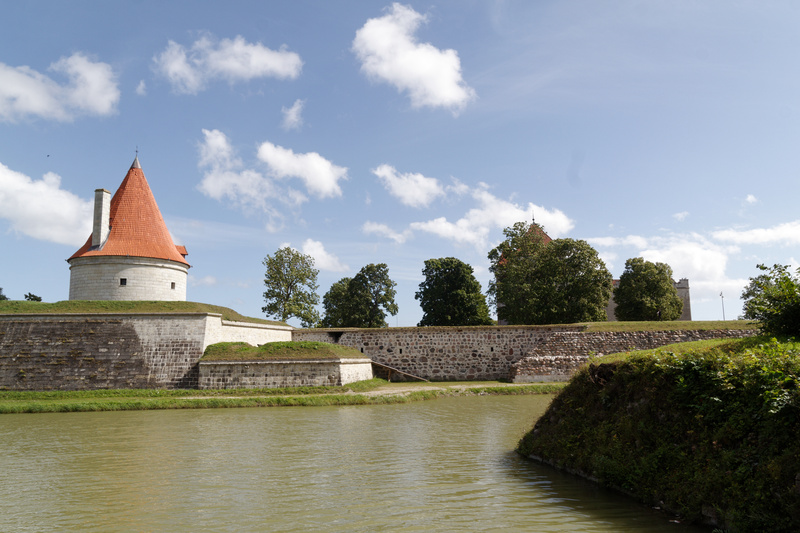
Kuressaare castle on Saaremaa, built by the Teutonic Order in the 14th century. |
Estonia was conquered by crusading German warrior monks in the 13th century, and Estonians basically spent the next seven centuries ruled by a German overclass. Above that overclass came first Swedish masters, then the Russians.
To be Estonian was to be a peasant, looked down on and oppressed by people of other ethnicities. All culture of any status was city culture, created by Germans, Swedes, or Russians. Estonians who managed to get an education and get ahead in society became German or Russian speakers and often changed their names.
In the 19th century an Estonian national consciousness started developing: a sense of Estonia as a nation of its own, with a language and culture of real value. The centre of this development was the University of Tartu, which was why the national museum was here, rather than in the capital, Tallinn. (The city was of course known by its German name, Dorpat, back then.)
After the Russian revolution in 1917 the Russian Empire fell apart, and Estonia escaped Moscow's clutches by declaring itself independent. Suddenly Estonia was a free nation, in a position to develop as it pleased.
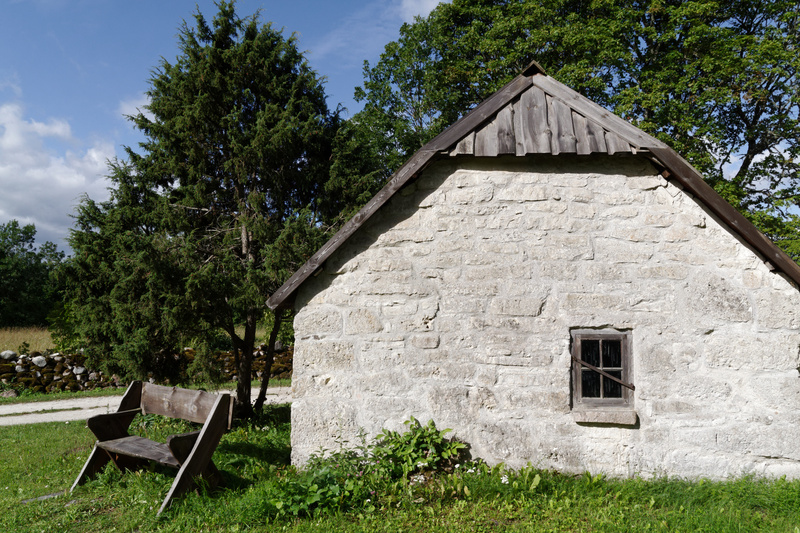
Old peasant house in Koguva, on Muhu. |
A major part of this project, which started even before Estonian independence, was to define what it meant to be an Estonian, and to show that this was a valuable thing. A nationalistic project to rebuild confidence in Estonian ethnicity, if you will.
Documenting the national culture was a major part of it. That's why Estonians were doing these massive surveys of their own culture, and it's also why Estonians responded so overwhelmingly to the questionnaire.
Volume 33 covered 1937 to 1939. Volume 51 was December 1939.
Going through these answers later it became very clear that at this time farmhouse brewing was going on all over Estonia. Every single answer seemed to say the same: yes, beer is still being brewed at home here. The impression I get is that in the late 1930s farmhouse brewing in Estonia was something most households did.
Those dates were kind of ominous, though. I turned to the last volume, 55. March 1940 to September 1940. Wasn't that when ...?
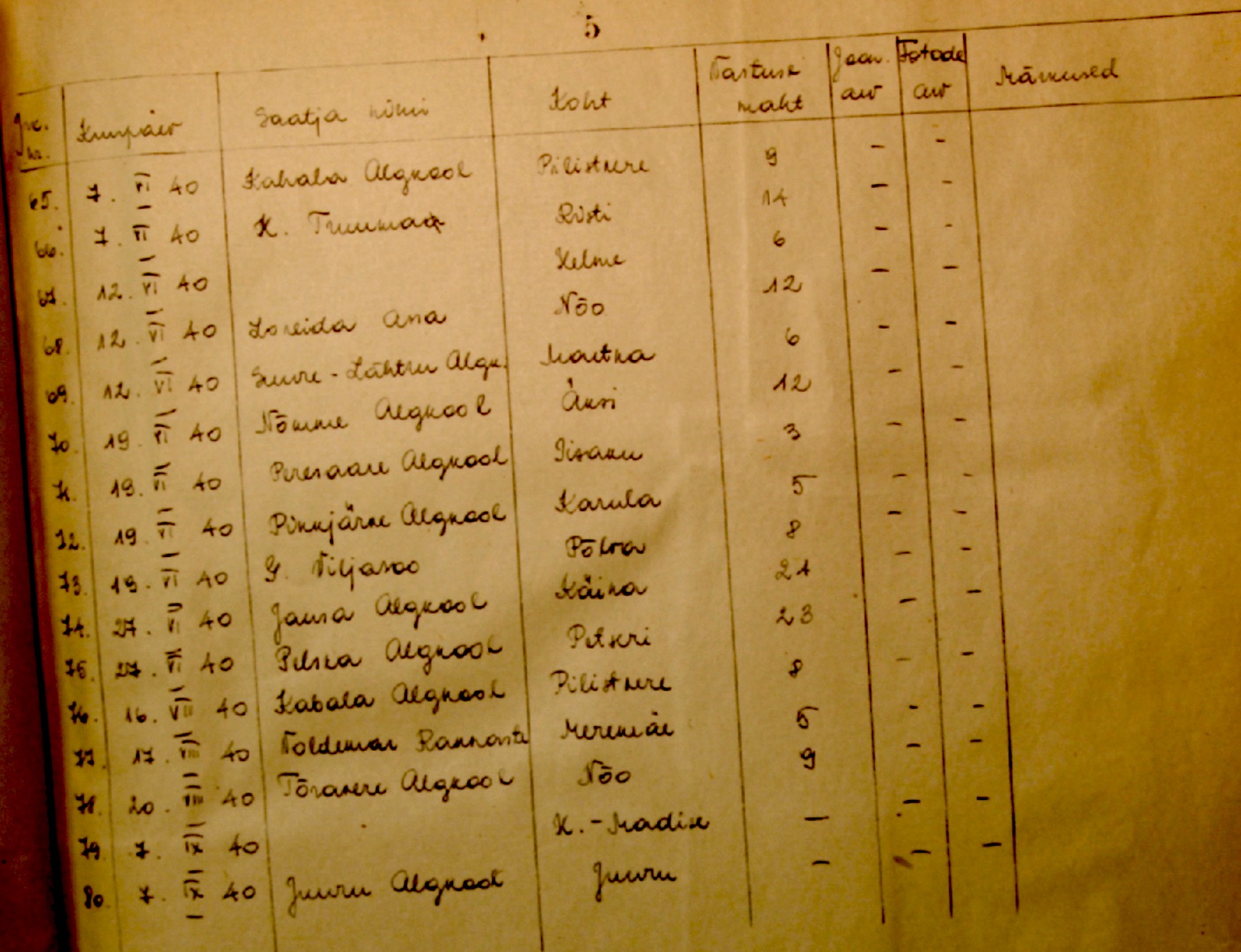
The index of volume 55. While Estonia was being occupied, some nameless archivist sat in the museum, recording new entries. |
I checked wikipedia. Sure enough. 17th of June 1940 was when Estonia capitulated to Moscow's demands, and Soviet tanks rolled in. On August 6 Estonia was declared part of the Soviet Union.
The national project was abruptly cut off. Estonia was subject to Moscow's domination, and its economic progress choked by communism.
I will not recount the atrocities they suffered. The arrests, the deportations, the torture, the executions. The goal, as it was in so many other eastern European nations around this time, was to exterminate the nation's elite. To decapitate the nation, in a phrase that's been much used the last few days. There was a monster in the Kremlin then, just as there is a monster in the Kremlin now.
I looked at the index of volume 55 again. Some answers arrived on 18th and 19th of June, probably mailed before the occupation started. Then the flood of answers slowed to a trickle, before stopping completely.
The occupiers had other concerns than to document Estonian national culture. Expressing Estonian national pride was no longer a wise thing to do.
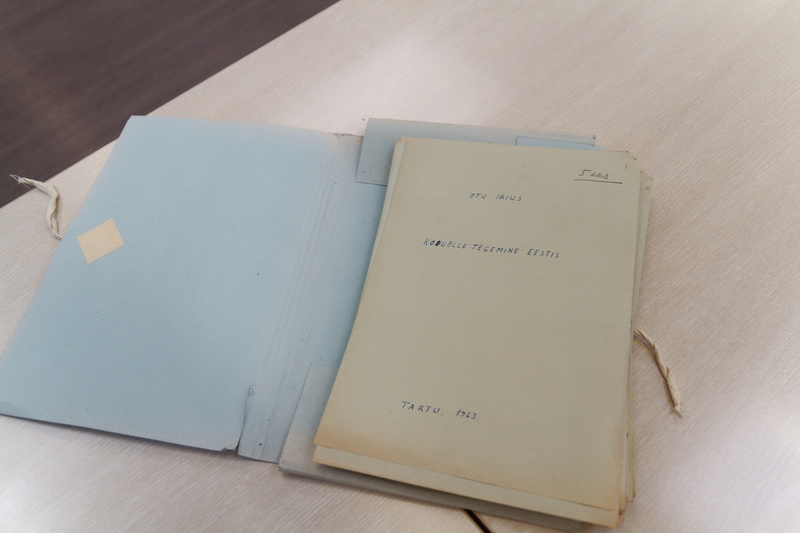
The manuscript of Oto Ibius's book. |
The day after I was in the Estonian national library, to look for the only proper history of Estonian brewing, written by Oto Ibius in 1963. They gave it to me in a paper folder, which contained one hand-written copy, and one carefully typewritten copy.
It was never published.
I made an electronic copy and sent it to Margo Samorokov, an Estonian historian, and he said it was a very valuable work. So why was it never published?
One of the key sources on Lithuanian keptinis is an article by Juozas Petrulis, published in 1975. It's quite brief and not very detailed.
Later, that summer, I met Simonas Gutautas, the brewer at Dundulis, by chance in the streets of Vilnius. Simonas is usually a quiet, taciturn man, but now he was talking like a machine gun, his brain clearly on fire.
He was coming straight from the Lithuanian national library where he'd just found Petrulis's notes. Literally 1000 hand-written pages of notes from extensive fieldwork. Precise details on hop growing, malting, brewing, drinking customs, ... A goldmine of information. Yet all it gave birth to was that short article.
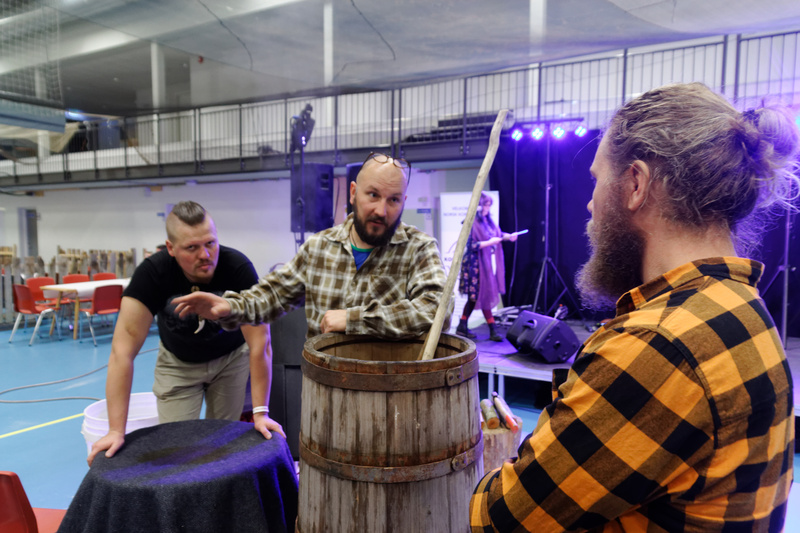
Simonas Gutautas (center) demonstrating Lithuanian brewing at Norsk Kornølfestival in Hornindal, Norway. |
Publishing work on Estonian and Lithuanian national culture under the Soviets was not easy.
My second main source on Estonian farmhouse brewing is the national museum's questionnaire 184, specifically on farmhouse brewing. The first answer was from March 1993.
When Gorbachev made it clear that he would not keep the Soviet republics in the union by armed force, they started tearing themselves loose. Estonia declared itself independent on August 20 1991.
The Estonian national project could now start again.
Within 18 months the national museum had put together that questionnaire on farmhouse brewing, found respondents, and received the first answer.
This time, the answers fit in a single slim volume.
The picture painted by this survey was very different. Now farmhouse brewing seemed to only be alive on the islands in the Baltic, except for, maybe, one or two villages on the mainland.
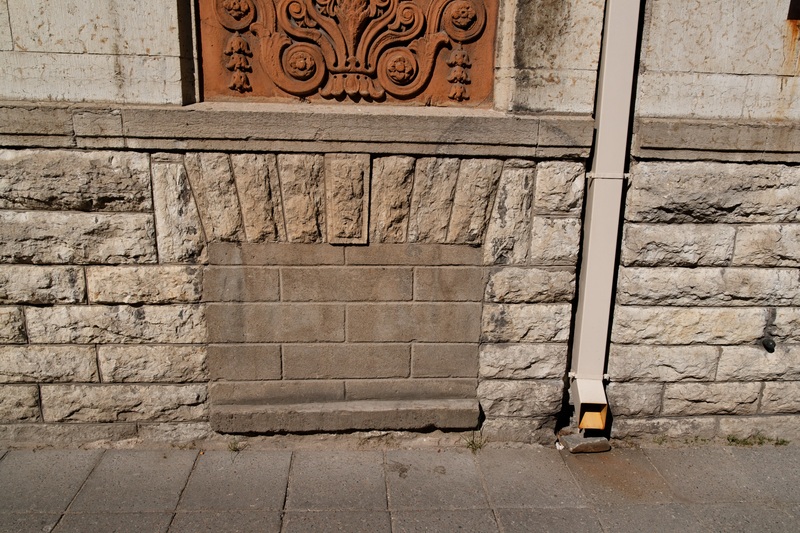
The cellar of KGB headquarters in Tallinn. In here Estonians were tortured and shot. The windows are bricked up so passers-by would not hear what was going on. You may recall that a certain Vladimir Putin started his career in this same organization, KGB. |
I'm not going to say the Soviet occupation was necessarily the reason why farmhouse brewing died on the mainland. It might have done so anyway. But the loss of so much Estonian national culture seems somehow symbolic for all the other losses that occupation caused.
Think back now to that huge, shiny, modern glass building, in some ways an unlikely setting for a museum of ethnography. I think you see now why Estonia decided this was important to invest in.
The reason I wrote this particular story, in this particular way, at this particular time I think you can also guess.
One of Putin's excuses for attacking Ukraine was that Ukraine is not really a country, and Ukrainians not really a nation. This is not a new idea. The only book of Russian ethnography I've been able to find was published in 1929. It describes the Russians as divided into three: the great Russians (centered on Moscow), the white Russians (Belarussians), and, condescendingly, the little Russians. Decent people call them Ukrainians.
Slava ukraini! Glory to Ukraine!
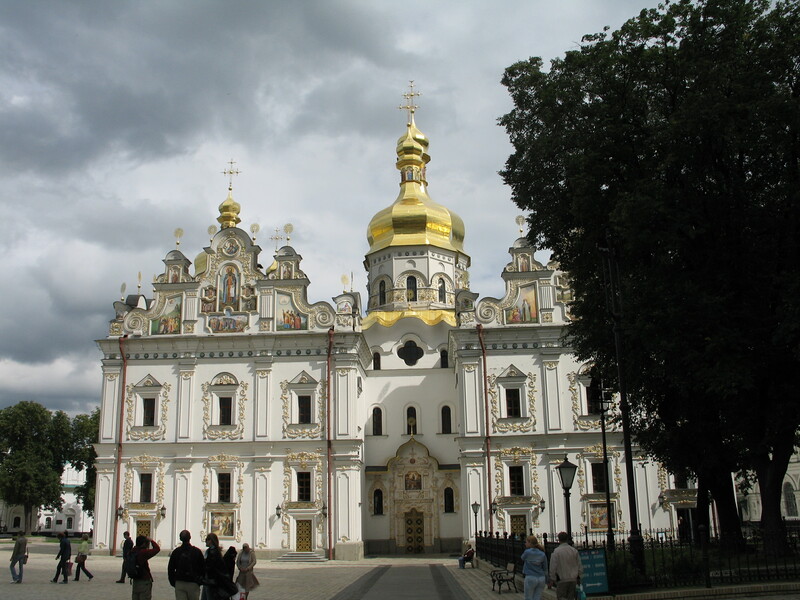
Dormition Cathedral, Kyiv, summer of 2006. |
Similar posts
Seto kingdom day
In south-eastern Estonia, and across the border in Russia, lives the Seto people
Read | 2017-11-05 10:36
Taarka Tarõ: A Seto restaurant
From the festival in Värska we drove on lonely forest roads to Obinitsa
Read | 2017-11-12 11:32
Comments
D Richards - 2022-02-26 21:04:04
Well done Lars for publishing this now.
Mike - 2022-02-27 00:38:51
Yes, well done on speaking up.
I read your book over Christmas. Found it a page turner and enjoyed it immensely.
Lars Marius - 2022-02-27 00:45:04
Thank you both. But, please, don't praise me for speaking up or being courageous. There's no courage in this. I risk nothing.
James Pettifor - 2022-02-27 16:08:58
Lars, You are right that in a free country you risk nothing by speaking out, but not speaking out is a crime in itself. Nothing like the crime that Putin and his corrupt lackeys are committing in Ukraine and seemingly would continue to commit elsewhere. So using your voice - however small - matters! We should all talk about this and take whatever other actions we are able to support the oppressed. Thank you.
Lars Marius - 2022-02-27 16:13:23
@James: I wholeheartedly agree with that comment. Absolutely! That's why I wrote this.
NICK TRAUSCH - 2022-02-27 19:15:06
Well done Lars. Hope you got some interesting info in the Estonian museum. Pray that they and their neighbors will be safe and that Ukraine will prevail. My wife is Slavic and there is a rich culture to be found.
Dave Pawson - 2022-02-28 11:31:02
Thanks Lars. Another gem.
Hans Üürike - 2022-03-01 09:41:48
Great job on looking into Estonian beer history. We appreciate this huge work ad for sure would like to have a future book from you about this. If our homebrewers community can help in any way, let us know. Hans
Lars Marius - 2022-03-01 11:11:23
Thanks guys.
Margo Samorokov and I did get a paper published in the Brewery History Journal.
@Hans: Especially good to hear this from an Estonian. Thank you! A book is not planned right now, but if I get more translated material in the future it might happen. I still have more documents that can be translated, so if you or someone else wants to work on some, email me any time.
Inge - 2022-03-01 18:16:04
Is there any hope that info from Petrulis's notes will be available to netizens at some point?
Lars Marius - 2022-03-01 18:35:57
@Inge: It's hard to say. I don't think it's likely to be published directly. I still haven't seen them, so I don't have photos of them. A thousand pages is doable in about a day, if they're well organized. But then there's translation. Obviously I will try, but there are many archives. No promises just yet.
Nick - 2022-03-15 17:50:19
Lars, thank you for keeping it real and for the hackers who brew:
Mykhailo Fedorov @FedorovMykhailo We are creating an IT army. We need digital talents. All operational tasks will be given here: https://t.me/itarmyofurraine There will be tasks for everyone. We continue to fight on the cyber front. The first task is on the channel for cyber specialists.
Nick Charles - 2022-04-26 22:06:56
Hi Lars, Speaking of Ukraine, while reading Olia Hercules recent “Summer Kitchen” (ISBN97816885704), the author recounts in her bread section on page 149 several time tested sources for yeast: overnight soured potatoes, hops crowns, hop cones and corn 🌽 flour mixed with grape must or pumice. Fermentation is a central process for food preparation throughout her book. The continuous use of wooden vessels is also touched on. The entirety of fermentation for bread, cheese, wine, beer, kvas, yogurt, fermented vegetables and the yeasts that make them, in theory, might have evolved under a single roof, the tiny building known in Ukraine as the Summer Kitchen. Given the disaster unfolding as we speak, this way of life is a Treasure on the brink of distraction. What’s at stake? Imagine two Grand Mothers, a multigenerational family, a small building, a set of wooden preparation vessels, a cornucopia of produce in season prepared sequentially as available with inter generational knowledge all accompanied by ever evolving yeasts and all place based with variation by local. I wonder if you might contact the author for an interview of discovery with her for one more adventure on the yeast discovery path. I would love to read what you discover! Thank you for all your work so far. Now is the time to get the word out! All the Best, Nick
greenspan - 2025-03-07 07:38:32
We offer loans worldwide at 2% interest rate, We offer Business Loan, Personal Loan, Car Loan, Investment Loan, Home Loan and much more. We offer loans from the range of $ 50,000.00 USD to $ 50,000,000.00, If interested contact us via below emails: expresseasyloan1@gmail.com We are also funding business project, We are interested in partnering with your company as we are seeking to diversify our financial portfolio into viable and lucrative business projects that worth it, We are most interested in partnership business ventures such as Medical and Health care projects, Real estate projects, mining projects, agricultural projects, renewable energy projects, start-up projects and business expansions / Loan with lower rate.
Your swift response is highly needed. Green Span Financial Loan Firm Email: greenspanfinancialloanfirm@gmail.com
greenspan - 2025-03-07 07:38:56
We offer loans worldwide at 2% interest rate, We offer Business Loan, Personal Loan, Car Loan, Investment Loan, Home Loan and much more. We offer loans from the range of $ 50,000.00 USD to $ 50,000,000.00, If interested contact us via below emails: expresseasyloan1@gmail.com We are also funding business project, We are interested in partnering with your company as we are seeking to diversify our financial portfolio into viable and lucrative business projects that worth it, We are most interested in partnership business ventures such as Medical and Health care projects, Real estate projects, mining projects, agricultural projects, renewable energy projects, start-up projects and business expansions / Loan with lower rate.
Your swift response is highly needed. Green Span Financial Loan Firm Email: greenspanfinancialloanfirm@gmail.com